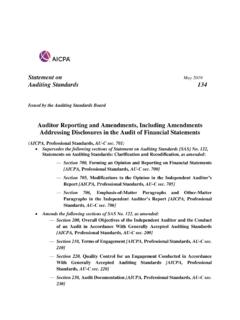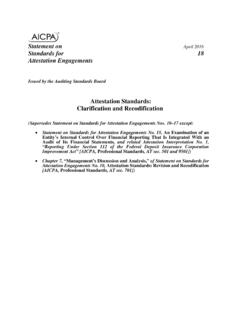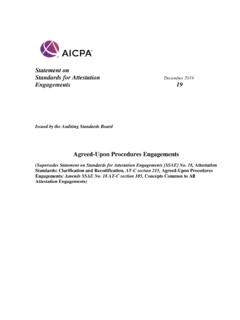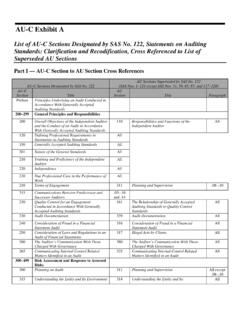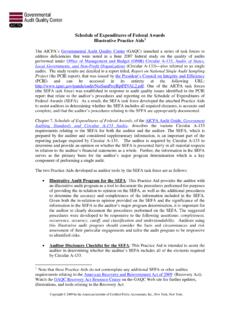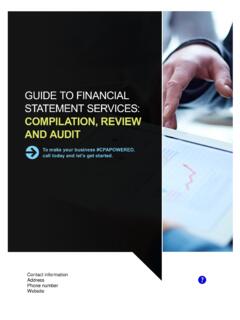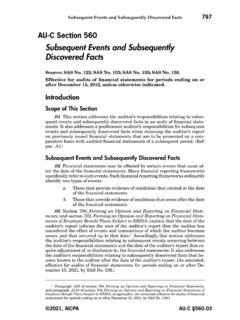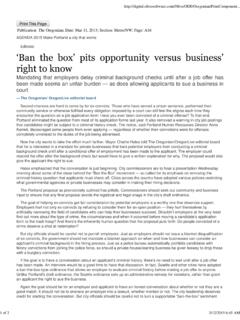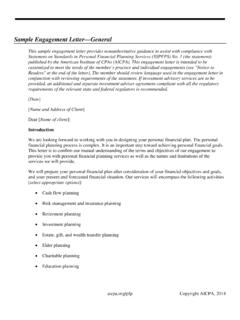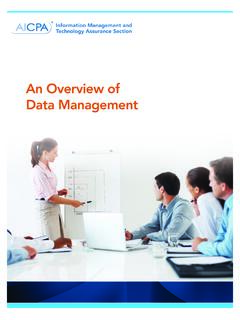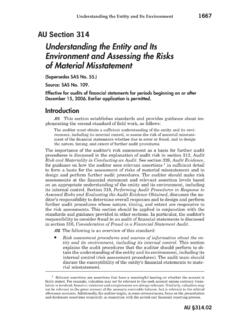Transcription of Consideration of Laws and Regulations in an Audit of …
1 Consideration of laws and Regulations207AU-C Section 250 Consideration of laws and Regulations in anAudit of Financial StatementsSource: SAS No. for audits of financial statements for periods ending on orafter December 15, of This section addresses the auditor's responsibility to consider laws andregulations in an Audit of financial statements. This section does not apply toother assurance engagements in which the auditor is specifically engaged totest and report separately on compliance with specific laws or of laws and effect on financial statements of laws and Regulations varies con-siderably. Those laws and Regulations to which an entity is subject constitutethe legal and regulatory framework.
2 The provisions of some laws or regulationshave a direct effect on the financial statements in that they determine the re-ported amounts and disclosures in an entity's financial statements. Other lawsor Regulations are to be complied with by management, or set the provisionsunder which the entity is allowed to conduct its business, but do not have adirect effect on an entity's financial statements. Some entities operate in heav-ily regulated industries (such as banks and chemical companies). Others aresubject only to the many laws and Regulations that relate generally to the op-erating aspects of the business (such as those related to occupational safetyand health and equal employment opportunity).
3 Noncompliance with laws andregulations may result in fines, litigation, or other consequences for the entitythat may have a material effect on the financial for Compliance With laws and Regulations (Ref: par..A1 .A7)Responsibility of is the responsibility of management, with the oversight of thosecharged with governance, to ensure that the entity's operations are conductedin accordance with the provisions of laws and Regulations , including compli-ance with the provisions of laws and Regulations that determine the reportedamounts and disclosures in an entity's financial 935,Compliance Audits, addresses compliance audits performed in accordance withgenerally accepted auditing standards, the standards for financial audits underGovernment AuditingStandards, and government Audit requirements.
4 2021, AICPAAU-C Principles and ResponsibilitiesResponsibility of the requirements in this section are designed to assist the auditorin identifying material misstatement of the financial statements due to non-compliance with laws and Regulations . However, the auditor is not responsiblefor preventing noncompliance and cannot be expected to detect noncompliancewith all laws and auditor is responsible for obtaining reasonable assurance that thefinancial statements as a whole are free from material misstatement, whethercaused by fraud or conducting an Audit of financial statements, theauditor takes into account the applicable legal and regulatory framework. Be-cause of the inherent limitations of an Audit , an unavoidable risk exists thatsome material misstatements in the financial statements may not be detected,even though the Audit is properly planned and performed in accordance withgenerally accepted auditing standards (GAAS).
5 3In the context of laws and reg-ulations, the potential effects of inherent limitations on the auditor's ability todetect material misstatements are greater for the following reasons: Many laws and Regulations relating principally to the operatingaspects of an entity typically do not affect the financial statementsand are not captured by the entity's information systems relevantto financial reporting. Noncompliance may involve conduct designed to conceal it, suchas collusion, forgery, deliberate failure to record transactions,management override of controls, or intentional misrepresenta-tions made to the auditor. Whether an act constitutes noncompliance is ultimately a matterfor legal determination, such as by a court of , the further removed noncompliance is from the events and trans-actions reflected in the financial statements, the less likely the auditor is tobecome aware of, or recognize, the section distinguishes the auditor's responsibilities regarding com-pliance with the following two categories of laws and provisions of those laws and Regulations generally recognizedto have a direct effect on the determination of material amountsand disclosures in the financial statements, such as tax and pen-sion laws and Regulations (see paragraph.)
6 13) provisions of other laws and Regulations that do not have adirect effect on the determination of the amounts and disclosuresin the financial statements but compliance with which may bei. fundamental to the operating aspects of the business,ii. fundamental to an entity's ability to continue its business,oriii. necessary for the entity to avoid material penalties(for example, compliance with the terms of an operating license, regulatory sol-vency requirements, or environmental Regulations ); therefore, noncompliancewith such laws and Regulations may have a material effect on the financialstatements (see paragraph .14).2 Paragraph .12 of section 200,Overall Objectives of the Independent Auditor and the Conduct ofan Audit in Accordance With Generally Accepted Auditing.
7 A49 of section 2021, AICPAC onsideration of laws and this section, differing requirements are specified for each of the pre-viously mentioned categories of laws and Regulations . For the category referredto in paragraph .06a, the auditor's responsibility is to obtain sufficient appropri-ate Audit evidence regarding material amounts and disclosures in the financialstatements that are determined by the provisions of those laws and the category referred to in paragraph .06b, the auditor's responsibility islimited to performing specified Audit procedures that may identify noncompli-ance with those laws and Regulations that may have a material effect on thefinancial auditor is required by this section to remain alert to the possibil-ity that other Audit procedures applied for the purpose of forming an opinionon financial statements may bring instances of identified or suspected noncom-pliance with laws and Regulations to the auditor's attention.
8 Maintaining pro-fessional skepticism throughout the Audit , as required by section 200,OverallObjectives of the Independent Auditor and the Conduct of an Audit in Accor-dance With Generally Accepted Auditing Standards, is important in this con-text, given the extent of laws and Regulations that affect the section is effective for audits of financial statements for periodsending on or after December 15, objectives of the auditor are sufficient appropriate Audit evidence regarding materialamounts and disclosures in the financial statements that are de-termined by the provisions of those laws and Regulations gener-ally recognized to have a direct effect on their determination (seeparagraph.)
9 06a), specified Audit procedures that may identify instances ofnoncompliance with other laws and Regulations that may have amaterial effect on the financial statements (see paragraph .06b), appropriately to noncompliance or suspected noncompli-ance with laws and Regulations identified during the the purposes of this section, the following term has the meaningattributed as of omission or commission by the entity, ei-ther intentional or unintentional, which are contrary to the pre-vailing laws or Regulations . Such acts include transactions en-tered into by, or in the name of, the entity or on its behalf bythose charged with governance, management, or employees. Non-compliance does not include personal misconduct (unrelated tothe business activities of the entity) by those charged with gover-nance, management, or employees of the.
10 17 of section 200. 2021, AICPAAU-C Principles and ResponsibilitiesRequirementsThe Auditor s Consideration of Compliance With Lawsand part of obtaining an understanding of the entity and its environ-ment, in accordance with section 315,Understanding the Entity and Its Envi-ronment and Assessing the Risks of Material Misstatement, the auditor shouldobtain a general understanding of the following:5(Ref: par..A8) legal and regulatory framework applicable to the entity andthe industry or sector in which the entity the entity is complying with that auditor should obtain sufficient appropriate Audit evidence re-garding material amounts and disclosures in the financial statements that aredetermined by the provisions of those laws and Regulations generally recog-nized to have a direct effect on their determination (see paragraph.)
